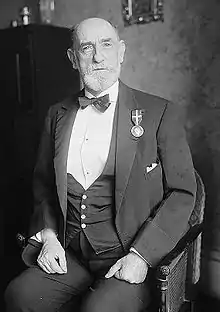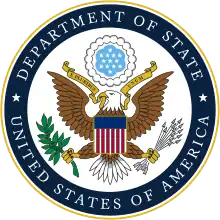Maurice Francis Egan | |
|---|---|
 Egan in 1923, wearing the Medal of Merit (Denmark) | |
| United States Minister to Denmark | |
| In office September 6, 1907 – December 16, 1917 | |
| President | Theodore Roosevelt William Howard Taft Woodrow Wilson |
| Preceded by | Thomas J. O'Brien |
| Succeeded by | Norman Hapgood |
| Personal details | |
| Born | May 24, 1852 Philadelphia, Pennsylvania |
| Died | January 15, 1924 (aged 71) Brooklyn, New York |
| Education | |
| Occupation | Writer, diplomat |
| Awards | Medal of Merit Grand Cross, Order of the Dannebrog |
| Signature | |
Maurice Francis Egan (May 24, 1852 – January 15, 1924) was an American writer and diplomat. He was a prolific writer and had a long and successful career as a Catholic journalist, literary critic, and novelist. He was a professor of English at two universities, and served as United States Minister in Copenhagen.[1][2]
Life and career
Egan's father was an immigrant from County Tipperary, Ireland who became a successful industrialist. His mother was from Philadelphia. Egan was born in Philadelphia in 1852. He received his secondary education from Brothers of the Christian Schools (FSC) at the newly opened LaSalle College. He did graduate work in journalism at Georgetown University, Washington, D.C.[1][2]
Egan returned to Philadelphia in 1877. His father urged him to pursue a career in law, but Egan instead began to contribute to The Saturday Evening Post magazine. His first novel That Girl of Mine, an implausible romance set in Washington, D.C. society, was published in 1877. Egan wrote the novel in two weeks for a pulp romance series. It was successful, and Egan wrote a sequel titled That Lover of Mine for the same series in 1877.[2]
Egan moved to New York in 1878. He used the network of Catholic publications to further his career, first becoming an editor at the Catholic journal Magee's Weekly. He then moved to the Illustrated Catholic American, and later to P. V. Hickey's Catholic Review. He became associate editor of the Freeman's Journal in 1881. He wrote essays, poems, reviews, and short fiction throughout the 1880s. Egan had become a respected Catholic writer by the 1890s. The 1890s was his most productive decade as a writer.[2]
Egan was professor of English at the University of Notre Dame from 1888 to 1896. He was professor of English at The Catholic University of America, Washington D.C. from 1896 to 1907.[1][3] He was an editor of the landmark ten volume Irish Literature (1904). His essay on "Irish Novels" was included in the book.[2] He was a friend of US President Theodore Roosevelt, and introduced him to William Butler Yeats at a White House lunch.[4]
Egan resigned his professorship and left academic life when President Roosevelt appointed him United States Ambassador to Denmark.[3][4] His appointment was a reward for his services as an unofficial contact with the hierarchy of the Catholic Church about Church-State problems in the Philippines and other countries.[5] He continued in this post under Presidents William Howard Taft and Woodrow Wilson. He facilitated the purchase of the Danish West Indies (renamed the United States Virgin Islands) in 1917.[6] This sale was the culmination of years of efforts on the part of Egan to get the Danes to sell these islands.[7] He resigned his position because of ill-health, and left Copenhagen for the United States on 16 December 1917.[8]
In 1908 he was elected to the American Academy of Arts and Letters. He was awarded the University of Notre Dame's Laetare Medal, an award for an outstanding Catholic, in 1910.[3][9]
His autobiography Recollections of a Happy Life was published in 1924.
He died in New York on January 15, 1924.[10][11]
Awards and honors
- Laetare Medal, University of Notre Dame, 1910
 Grand Cross of the Order of the Dannebrog, 1918 [12]
Grand Cross of the Order of the Dannebrog, 1918 [12]- Medal of Merit, Denmark, 1924 [13]
Works
Egan published poetry in Ave Maria, Sacred Heart Messenger, The Century, and The Saturday Evening Post. He published twelve novels, including The Disappearance of John Longworthy (1890), The Success of Patrick Desmond (1893), and The Vocation of Edward Conway (1896). His most popular novel was The Wiles of Sexton Maginnis (1909), which was about a shaughraun, or vagabond, who never lies "except in the interest of truth". His novels were romantic and melodramatic, mixing some realism with the romantic conventions of 19th century literature. They depicted lives of contemporary urban Catholics in the United States, showing Irish Catholics learning how to practise their religion in the United States. His novels promoted genteel middle-class values.[2][4] Egan was perhaps the first Irish American author to exchange the Irish part of their background for a genteel Catholic middle class identity.[14] This was a common trade-off among his generation of Irish Americans.[2]
Bibliography
Works by Maurice Francis Egan include:
Fiction
- That Girl of Mine (1877)
- That Lover of Mine (1877)
- The Life Around Us: a Collection of Stories (1885)
- The Success of Patrick Desmond (1893)
- A Marriage of Reason (1893)
- The Vocation of Edward Conway (1896)
- Jack Chumleigh at boarding-school (1899)
- The Disappearance of John Longworthy (1890)
- The Wiles of Sexton Maginnis (1909)
- The Ivy Hedge (1914)
Non-fiction
- The Theatre and Christian Parents (1885)
- The Ghost in Hamlet, and other essays in comparative literature (1906)
- Everybody's St. Francis (1912)
- Studies in Literature. Some words about Chaucer, and other essays (1916)
- The Corona Readers with James Hiram Fassett (1916)
- Ten Years Near the German Frontier: A Retrospect and a Warning (1919)
- The Knights of Columbus in Peace and War with John James Bright Kennedy (1920)
- Confessions of a Book-Lover (1920)
- Recollections of a Happy Life (1924)
References
- 1 2 3 Pierce, David (2000). Irish Writing in the Twentieth Century: A Reader. Cork University Press. p. 22. ISBN 1-85918-258-5.
- 1 2 3 4 5 6 7 Fanning, Charles (1999). The Irish Voice in America: 250 Years of Irish-American Fiction. University Press of Kentucky. ISBN 0-8131-0970-1.
- 1 2 3 O'Reilly, Gerald (May 1, 2003). "Laetare Lesson". Notre Dame Magazine. Archived from the original on June 9, 2007. Retrieved December 20, 2007.
- 1 2 3 "Maurice Egan". Princess Grace Irish Library (Monaco). Archived from the original on July 4, 2008. Retrieved December 20, 2007.
- ↑ Shannon, William V., 1989, The American Irish: A Political and Social Portrait, ISBN 0-87023-689-X, p. 328.
- ↑ "Papers Relating to the Foreign Relations of the United States, with the Address of the President to Congress December 4, 1917 - Office of the Historian".
- ↑ "Maurice Francis Egan: Writer, Teacher, Diplomat by Caroline Patrice Peck at College of William & Mary - Arts & Sciences". scholarworks.wm.edu.
- ↑ Foreign Service Register and biographical index, United States Department of State
- ↑ "People: Mar. 18, 1929". Time magazine. March 18, 1929. Archived from the original on October 27, 2010. Retrieved December 25, 2010.
Diplomat Maurice Francis Egan (1910)
- ↑ "Maurice F. Egan, Noted Diplomat And Writer, Dies". New York Times. January 16, 1924. Retrieved December 25, 2010.
Dr. Maurice Francis Egan, former minister to Denmark, died at his home in Brooklyn late today. Dr. Egan had been ill for several months.
- ↑ "Dr. M. F. Egan Dies, Author-Diplomat; Former U. S. Minister to Denmark Expires in Brooklyn After a Long Illness. I HONORED BY DANISH 'KING Ex-Professor at Catholic University Was a Prolific Writer on Many Subjects". The New York Times. January 16, 1924. Retrieved June 23, 2018.
- ↑ "Maurice Francis Egan: Writer, Teacher, Diplomat". Retrieved July 29, 2020.
- ↑ "The American ambassador's memorandums about the sale". The Danish West-Indies. Retrieved July 29, 2020.
- ↑ Kane, Paula M. (2001). Separatism and Subculture: Boston Catholicism, 1900-1920. UNC Press Books. p. 292. ISBN 0-8078-5364-X.
External links
- Works by Maurice Francis Egan at Project Gutenberg
- Works by or about Maurice F. Egan at Internet Archive
- Works by Maurice F. Egan at LibriVox (public domain audiobooks)

- "Slumbering Volcano of the Modern World; A Review by MAURICE FRANCIS EGAN". New York Times. September 17, 1922. Retrieved August 8, 2008. Maurice Francis Egan's 1922 review of a book by John Marriott.
